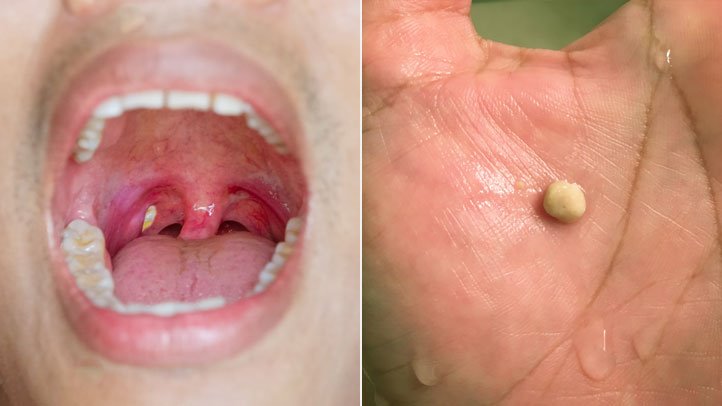Tonsil Stones: How to Get Rid of Them!

TONSIL STONES ARE WHITE HARD DEPOSITS WHICH LOOK LIKE ROCKS COLLECTING IN YOUR TONSILS (BACK OF YOUR THROAT). THE ABOVE PICTURE SHOWS A TONSIL STONE STUCK IN THE RIGHT TONSIL (LEFT) AND THE ACTUAL TONSIL STONE AFTER IT HAS BEEN REMOVED (RIGHT).
Ever wondered why you keep on suffering from bad breath, sore throat or a feeling of something stuck in the back of your throat? Well, one of the possible reasons may be due to the presence of tonsil stones growing at the back of your throat! At our ENT specialist clinics in Singapore, the ENT specialist doctors see patients who turn up with recurrent sore throats, throat irritation causing a feeling of something stuck at the back of the throat and persistent bad breath. One careful look in the back of some people’s throats and one may spot a few white, hard, rock-like deposits in the tonsils, which may sometimes appear covered in cheesy sticky mucus/slime.
Tonsil stones form in our ENT patients’ throats in Singapore because your tonsils have been producing a lot of whitish thick mucus which dries up to form solid deposits, “stones”. They may cause bad breath because the mucus tends to be infected and can be rather unpleasant-smelling.
These tonsil stones may have been bothering you for quite some time and somehow, just don’t seem to disappear. Worse, they may be rather tricky to remove by yourself. If you decide to use a sharp tool to dig the tonsil stones out, please be very careful as this may result in bleeding.
Here are Dr Annabelle’s tips to safely remove those nasty irritating tonsil stones:
- Gargling with an antibacterial mouthwash may help to dislodge the tonsil stones and cleanse the back of your throat to prevent them from recurring. Sometimes, even gargling with some diluted cider vinegar may help as it acts as an antiseptic to clean your throat.
- Drinking plenty of water ie 6 – 8 glasses of water everyday will help to keep you well-hydrated, which in turn may help to reduce the thick secretions and mucus from forming on the tonsil surfaces.
- Taking a course of antibiotics may help to treat any infection related to the trapped tonsil stones and so, help to reduce the severity of the bad breath associated with these tonsil stones.
- Cleaning the tonsils gently with a cotton swab or cotton bud may help to loosen the tonsil stones. If you’re feeling brave enough, using a toothpick with a steady hand may sometimes be effective in rooting out those trapped tonsil stones. But this may not be so easy to do especially if there is a tonsil or throat infection causing pain. If you have a strong gag reflex, trying to dig out those tonsil stones may make you retch uncontrollably or even vomit when the back of your throat is touched.
- If all else fails, see your friendly ENT specialist doctor in Singapore to get it checked out properly: Discuss with your best ENT specialist in Singapore if a tonsillectomy is the way forward for you to permanently remove the source of those tonsil stones, the tonsils! Having a tonsillectomy may seem daunting at first but it actually is a very effective way to treat those recurrent throat infections and tonsil stones. The immune system in older children, teenagers and adults does not depend on the tonsils to be strong and effective so there is no concern about removing your tonsils if they continue to bother you with infection and tonsil stones like this. Expect a sore throat in the first few days after tonsil surgery but after that, you should feel much better and never have to worry about tonsil infections and tonsil stones ever again. There is also a good chance that the associated bad breath (halitosis) will improve!
So for those of you who have had to suffer persistent throat infections, tonsillitis and bad breath, tonsil stones may not only be the root of the problem, but may be the sign of chronic tonsil infections.
Share this blog via:
